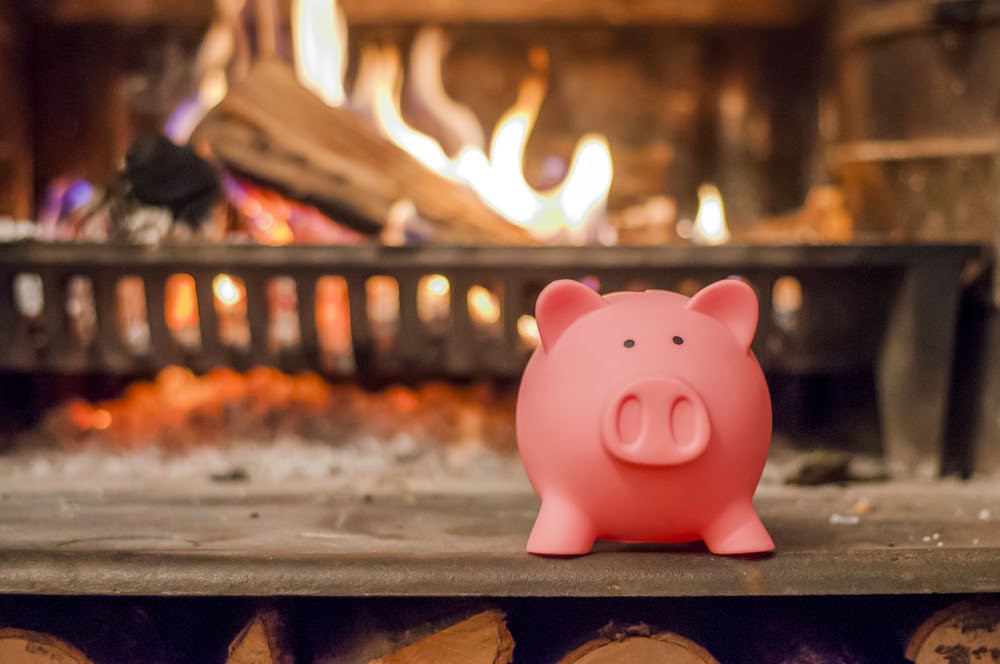An Energy-Efficient Fireplace Warms the Space on a Cooler Budget
Heating a home during a brutally cold winter can leave quite a dent in the monthly budget. Heating and cooling comprises a substantial portion of a home’s energy use, and, in turn, is a major contributor to the price of energy each month.
Some homeowners might use a fireplace to add additional warmth to a space and take a bit of the heat off the furnace. For homeowners that want to cut costs and save energy, choosing an energy-efficient fireplace warms the home on a cooler budget.

The Problem with Traditional Fireplaces
Homeowners might perceive a traditional wood-burning fireplace to be the source of free heat. After all, wood is cheap…and sometimes free. The cost of using a traditional fireplace is low, so, therefore, wouldn’t the traditional fireplace be the most energy-efficient choice?
The problem with the wood fireplace isn’t the cost of wood. The real issue is that a traditional fireplace requires ventilation in the form of a chimney. Homeowners need to understand that a chimney is technically a hole in the roof.
Chimneys let smoke ventilate from the fireplace. However, the chimney also lets air escape. Both hot air and cold air can enter through the chimney. So while the fireplace is inexpensive to use and operate, requiring no gas or electricity, the issue is the chimney as a source of energy waste.
Natural Gas, Electricity and an Energy-Efficient Fireplace
Natural gas could be a more eco-friendly option for warming the home. While standard fireplaces use wood to heat the home, gas fireplaces trade-in logs for natural gas options that are used to warm the home via the fireplace.
Gas fireplaces might have been perceived as the most energy-efficient choice for those who want to stay away from the traditional fireplace (and lighting logs). However, VolunteerEnergy explains that electric fireplace options are the most energy-efficient.
Why are gas fireplaces not so sustainable or energy-efficient? Like traditional fireplaces, gas fireplaces let heat escape from the chimney. While logs can be inexpensive and sometimes free, gas is not. And, unfortunately, now the price of natural gas is skyrocketing…and this could add a significant dent to the homeowner’s budget.
Choosing the Best Energy-Efficient Fireplace
Some homes might feature a traditional fireplace. Homeowners could use the fireplace to help heat their home or decide to simply leave the fireplace as a merely decorative element.
However, that traditional fireplace can be switched to an electric option. In fact, the price to transform a traditional fireplace to a more energy-efficient electric option is around $200 plus the cost of an electric insert.
Homeowners with children might opt for electricity for safety reasons, too. Electric fireplaces don’t offer real flames, although they do include faux flames. This means less burn risk for children.
While some homeowners might eye natural gas fireplaces, they might want to consider the rising cost of that energy source. If the home’s furnace operates via natural gas, they might already face high costs during extremely cold winters.
Burn Wise and the Environmental Protection Agency
Homeowners shopping for an energy-efficient fireplace might wonder if they need to look for a specific label—like ENERGY STAR. While ENERGY STAR doesn’t list fireplaces amongst its labeled products, the Environmental Protection Agency offers a Burn Wise guide for homeowners.
Burn Wise covers wood-burning heating options. The EPA also details how the use of a traditional fireplace might not be the best choice for homeowners to heat their home. Instead, they might choose cleaner, more efficient options.

Warm Up Without the Extra Costs
While it might seem counterintuitive to think that using a standard fireplace would waste energy, this is, unfortunately, the case for homeowners. Wood-burning fireplaces suck heat out of the home, and this could be a source of energy drain.
Gas fireplace options pose similar issues. In addition, the cost of natural gas is on the rise. Homeowners who use natural gas to heat their furnace might already face a brutally expensive winter.
Electric fireplaces might be the most energy-efficient and inexpensive option. Homeowners can convert a traditional fireplace to an electric option to save money and add some additional warmth to the home. While electric fireplaces don’t use real flames, they often project faux flames to add cozy ambiance.
Homeowners also could decide to skip the fireplace completely. Those who want the ambiance of the warm fireplace also have another option: the fireplace via television. Adding a fireplace to the home is an additional cost, but for homeowners who want to sip hot chocolate by the fire, the flickering image of the fireplace via the television screen might be the next best thing…without much additional cost or energy use!


